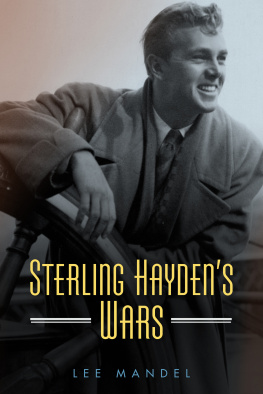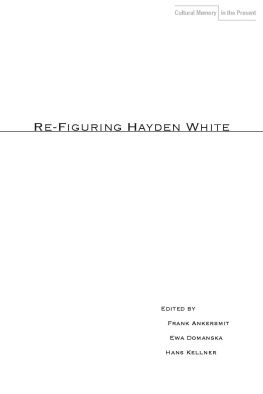
STERLING HAYDENS WARS
HOLLYWOOD LEGENDS SERIES
CARL ROLLYSON, GENERAL EDITOR

STERLING HAYDENS
 WARS
WARS 
LEE MANDEL
UNIVERSITY PRESS OF MISSISSIPPI JACKSON
www.upress.state.ms.us
Designed by Peter D. Halverson
The University Press of Mississippi is a member of the Association of University Presses.
Frontispiece from the Sterling Hayden Collection, Howard Gotlieb Archival Research Center at Boston University.
Copyright 2018 by University Press of Mississippi
All rights reserved
Manufactured in the United States
First printing 2018
Library of Congress Cataloging-in-Publication Data
Names: Mandel, Lee author.
Title: Sterling Haydens wars / Lee Mandel.
Description: Jackson : University Press of Mississippi, 2018. | Series: Hollywood legends | Includes bibliographical references and index. |
Identifiers: LCCN 2017048919 (print) | LCCN 2017053197 (ebook) | ISBN 9781496816986 (epub single) | ISBN 9781496816993 (epub institutional) | ISBN 9781496817006 (pdf single) | ISBN 9781496817013 (pdf institutional) | ISBN 9781496816979 (cloth : alk. paper)
Subjects: LCSH: Hayden, Sterling, 19161986. | ActorsUnited StatesBiography.
Classification: LCC PN2287.H34 (ebook) | LCC PN2287.H34 M36 2018 (print) | DDC 791.4302/8092 [B] dc23
LC record available at https://lccn.loc.gov/2017048919
British Library Cataloging-in-Publication Data available
THIS BOOK IS DEDICATED TO CATHERINE KITTY HAYDEN,
THE LOVE OF STERLING HAYDENS LIFE.
CONTENTS
ACKNOWLEDGMENTS
THERE ARE SEVERAL PEOPLE THAT I WOULD LIKE TO ACKNOWLEDGE FOR their invaluable assistance in writing this book. I was fortunate enough to be able to speak with two of Sterling Haydens friends who shared recollections of their times together with him. Through the efforts of film archivist Susan Strange, I spoke on several occasions with Norm Hatch, Haydens friend and colleague since they were teenagers. I also was able to interview film producer Dennis Powers, who was the youngest member of the crew of the Wanderer when Hayden captained the schooner to Tahiti in 1959. Their insights into the mind and character of Sterling Hayden were invaluable.
The behind-the-scenes staff at the National Archives in College Park, Maryland, provided excellent service during my research into Haydens World War II exploits, as did the staff at the Dwight D. Eisenhower Presidential Library. I was fortunate to be able to spend several days examining the Sterling Hayden Collection, the repository of his personal papers that are housed at the Howard Gotlieb Archival Research Center at Boston University. I am especially indebted to archivist Sarah Pratt for her assistance, as well as to Manager of Public Service Laura Russo.
Journalist Scott McConnell, Sterling Haydens stepson, graciously responded to my inquiries about his stepfather, and his daughter-in-law, Sarah Hayden, provided me encouragement throughout the writing of the book.
My greatest debt is to Catherine Kitty Hayden, Sterling Haydens widow, and to David Hayden, Sterling and Kittys youngest son. I originally took a chance and wrote them a letter explaining my interest in Sterling Hayden and attached the original draft of my manuscript. To my good fortune, they responded positively to my efforts and invited me to meet with them to discuss the various aspects of Sterlings life. Their candor was impressivethey helped flesh out the story of this remarkable man, warts and all. In addition, they shared photographs and documents with me that greatly enhanced my original manuscript. After our initial meetings, they authorized me to have access to the Sterling Hayden Collection at Boston University, and I became the only researcher ever granted such access. Over the ensuing months, they have put up with multiple phone calls from me and we have become close friends. As much as I enjoyed researching and writing this book, the greatest source of gratification for me has been my friendship with Kitty and David Hayden.
Lastly, I have to acknowledge my number one assistant and supporter, my wife Ann. She helped me through the entire process of writing this book, by proofreading, critiquing, and recommending changes in the manuscript. For over thirty years, she has been my partner and my greatest inspiration.
PROLOGUE
ADRIATIC SEA
DECEMBER 1943
THE CREW COULD SEE THAT THEIR CAPTAIN WAS IN THE FOULEST OF moods. Up to this point the mission had gone well. Making the transit across the Adriatic Sea to Yugoslavia, the mission was, as always, twofold. First, they had brought much needed supplies across the sea for the Yugoslav Partisans, led by Josef Broz, better known by his nom de guerre of Tito. The other purpose of the mission was to pick up Allied airmen who had bailed out over Yugoslavian territory, many of whom were wounded or injured. In addition, wounded Partisan combatants would also be evacuated back to the Allied base at Monopoli, Italy.
Departing from Monopoli in the evening, the boat operated by the Office of Strategic Services, commonly known as the OSS, had transited throughout the night and tied up in the morning in a hidden cove on the Dalmatian coast of Yugoslavia. Under the cover of the following night, they unloaded their cargo and departed back to Monopoli the following night. The transit was made perilous not only because of the Allied minefields off the Italian coast, but by the patrolling German boats. The Yugoslavian coast was patrolled by German E-boats, swift 108-foot vessels capable of speeds up to forty knots. The OSS fleet, comprised largely of armed fishing vessels, was no match for these boats, relying instead on stealth and superior seamanship. It was superior seamanship that the OSS boat captain brought to the mission, along with an almost reckless obsession for mission completion. His crew greatly admired his courage and leadership.
The captain was a huge man at six foot five and over two hundred pounds of muscle. He was a second lieutenant in the United States Marine Corps who had been accepted into the OSS and was in charge of all maritime operations at Monopoli. The strikingly handsome officer was named John Hamilton. Less than two years before, he had been known as Sterling Hayden, the star of two major Hollywood movies, Virginia and Bahama Passage, before he abruptly quit the film industry. After enlisting in the Marine Corps and then receiving an officers commission, he legally changed his name so he would not be tied to his previous persona. Although the men serving under him knew who he really was, woe to any of them who dared to address him by any name other than Capt. Hamilton. His men knew him as a no-nonsense, hard-drinking, missiondriven leader.
Hamilton had become increasingly frustrated with the British, who continued to treat the OSS as stepchildren. As a result of previous agreements reached between the two countries, the British Special Operations Executive, or SOE, was the senior partner in the Mediterranean theater of operations and in the Balkans. OSS personnel continually chafed under British restrictions and incidents that they perceived as British interference with their missions. Hamiltons patience with the British was nearing an end. His crew had already witnessed a display of Hamiltons mercurial temper on a prior mission.
On that previous mission they had rescued four American airmen from Yugoslavia and after departing the coast they were attacked by several German E-boats. Their vessel was shot up badly and they now had three seriously wounded airmen aboard. Unbeknownst to Hamilton, his glamorous wife, movie star Madeleine Carroll, had been brought to the pier back in Monopoli in a publicity stunt arranged by the Army and the Red Cross. Arriving at the pier, the livid Hamilton began screaming obscenities as he worked to evacuate his wounded passengers and inspect his damaged ship. He then turned to the Fifteenth Air Force public relations officer who had arranged the affair, Maj. Bernal Clark, and proceeded to grab him and throw him into the harbor.
Next page













 WARS
WARS